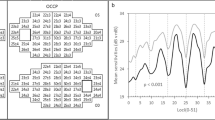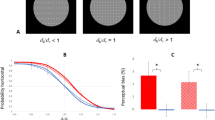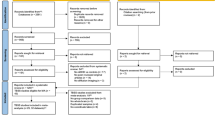Abstract
We studied the effect of varying the stimulus duration time on the components of fluctuation in static automated perimetry by testing 20 healthy subjects on the Humphrey Field Analyser within the central 20° of vision. We found the total fluctuation at a stimulus duration of 0.065 s, to be 3.22 decibels (dB); 0.1 s, 3.22 dB; 0.2 s, 3.34 dB;0.3 s,2.95 dB;0.4 s,3.24 dB; and 0.5 s,3.22 dB. Little difference was observed in the individual components (short-term, long-term homogeneous, long-term heterogeneous and inter-individual) or total fluctuation with an increasing stimulus presentation time when evaluated over the entire visual field or in a pointwise fashion. This study suggests that the stimulus duration within the range of times studied has little effect on the components or total fluctuation in healthy individuals.
Similar content being viewed by others
Log in or create a free account to read this content
Gain free access to this article, as well as selected content from this journal and more on nature.com
or
References
Heijl A, Lindgren G, Olsson J : Normal variability of static perimetric threshold values across the central visual field. Arch Ophthalmol 1987, 105: 1544–9.
Wilensky JT and Joondeph BC : Variation in visual field measurements with an automated perimeter. Am J Ophthalmol 1984, 97: 328–31.
Flammer J, Drance SM, Fankhauser F, Augustiny L : Differential light threshold in automated static perimetry. Factors influencing short-term fluctuation. Arch Ophthalmol 1984, 102: 876–9.
Flammer J, Drance SM, Zulauf M : Differential light threshold. Short- and long-term fluctuation in patients with glaucoma, normal controls, and patients with suspected glaucoma. Arch Ophthalmol 1984, 102: 704–6.
Heijl A and Drance SM : Changes in differential threshold in patients with glaucoma during prolonged perimetry. Br J Ophthalmol 1983, 67: 512–16.
Brenton RS and Argus WA : Fluctuations on the Humphrey and Octopus perimeters. Invest Ophthalmol Vis Sci 1987, 28: 767–71.
Graybill FA : Introduction to Linear Statistical Models. Vol. 1. New York. McGraw-Hill, 1961: 349–351.
Gilpin LB, Stewart WC, Hunt HH, Broom CD : Threshold variability using different Goldmann stimulus sizes. Acta Ophthalmol 1990, 68: 137–9.
Crosswell HH, Stewart WC, Cascairo MA, Hunt HH : The effect of background intensity on the components of fluctuation as determined by threshold-related automated perimetry. Graefe's Arch Clin Exp Ophthalmol 1991, 229: (in press).
Fankhauser F, Bebie H, Flammer J : Threshold fluctuations in the Humphrey field analyser and in Octopus automated perimeter. Invest Ophthalmol Vis Sci 1988, 29: 1466.
Tate G : The physiological basis for perimetry. In Drance SM, Anderson D, eds. Automated perimetry in glaucoma: A practical guide, Orlando: Grune & Stratton Inc. 1985: 18–21.
Stewart WC : Clinical practice of Glaucoma. Thorofare, NJ. Slack, Inc., 1990: 103.
Katz J and Sommer A : A longitudinal study of the age-adjusted variability of automated visual fields. Arch Ophthalmol 1987, 105: 1083–6.
Author information
Authors and Affiliations
Additional information
This research was supported in part by a grant from Research to Prevent Blindness, Inc.
Rights and permissions
About this article
Cite this article
Pennebaker, G., Stewart, W., Stewart, J. et al. The effect of stimulus duration upon the components of fluctuation in static automated perimetry. Eye 6, 353–355 (1992). https://doi.org/10.1038/eye.1992.72
Issue date:
DOI: https://doi.org/10.1038/eye.1992.72



